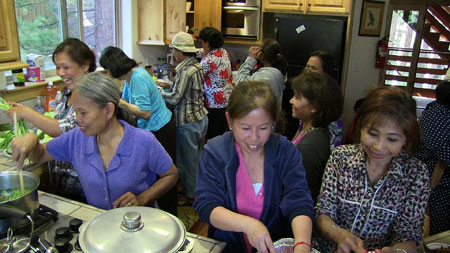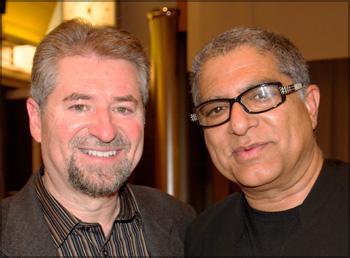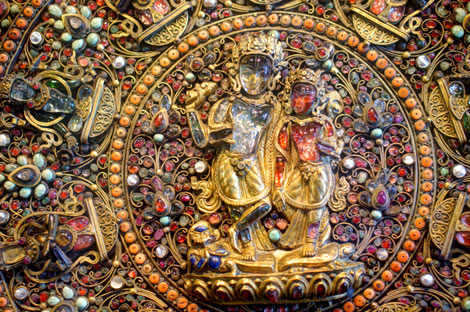by Alan Briskin | Community, Nature, Wellness
Call it a clan, call it a network, call it a tribe, call it a family: Whatever you call it, whoever you are, you need one. ~ Jane Howard

One of the stories featured in The Power of Collective Wisdom is about the Center for Empowering Refugees and Immigrants (CERI) in Oakland, California. Co-founded by Mona Afary, the center has been a tribe and network for Cambodian refugees and their families, many of whom escaped from the brutal regime of Pol Pot and the killing fields.
Mona’s initial inspiration for the center came from her observing that in the waiting room of her counseling office, a group of Cambodian clients and their families sat together talking and laughing, knitting together and trading stories. The possibility for healing was in front of her, in the interconnected web of life and love.
Read More
by Alan Briskin | Collective Wisdom, Consciousness, Health, Leadership, Poetry, Spirituality, Wellness
A poem based on phrases and fragments of a speech* given by Deepak Chopra:
My grandchildren are here today
the most important part for me.
Here is my question:
What if consciousness
was not
a byproduct of our brain?
What if instead
it is the ground of Being,
the basement of the Universe
in geometric space-time
where all co-exists
as possibilities.
The great Rishi wisdom teachings
tell us consciousness
cannot be imagined
but makes the imagination possible.
Can you imagine?
From the basement of space-time,
everything is born from a quantum vacuum,
Beauty, Truth, Love, Joy, Compassion,
and also our Diabolical Self.
There is only the collective mind
that shows up as the individual mind.
The sage plunges into it,
expresses it, becomes one with it.
Healing is nothing more than
the memory of wholeness
Nature can say that the
human species
was just an experiment
that didn’t work out
Or Not!
The frantic search for security
only reinforces the insecurity.
Surrender to the mystery
of the divine,
which is constantly on the move.
My grandchildren are
here today,
the most important part.

* Deepak Chopra’s speech, on which this poem was based, was given on the day he received the Goi Peace Award** in Tokyo, Japan, November 8th, 2010.
I was there as a moderator the following day for a panel discussion with Deepak and thought leaders from Japan on the subject of death and dying, and wrote the poem from fragments of his speech and the group conversation.
The mission of the Goi Peace Foundation, which sponsored both events, is to bring people together in wisdom, united in their hearts toward the common goal of peace on Earth. By encouraging public awareness and building cooperation among individuals and organizations in all fields, they aim to build an international peace network and stimulate the global trend toward a culture of peace.
by Alan Briskin | Collective Wisdom, Conscious Capitalism, Wellness

A serial journal of cogent reflections and irreverent insights on the social effects of capitalism and the roots of partisan politics. Pairing prose with HDR photography and “flash points” drawn from current and historical perspectives, the author seeks to recover lost wisdom and courageous action beyond the shouting and noise of today’s headlines.
Chapter Fifteen
Moving from Factions to the Whole
Paying Attention in New Ways
Part II: Mind – Body Perspectives
Time Range: NOW
 FLASH POINT
FLASH POINT
“The transformation of human consciousness is no longer a luxury, so to speak, available only to a few isolated individuals, but a necessity if humankind is not to destroy itself.
At the present time, the dysfunction of the old consciousness and the arising of the new are both accelerating. Paradoxically, things are getting worse and better at the same time, although the worse is more apparent because it makes so much `noise’.
Silence and Stillness
When you lose touch with inner stillness, you lose touch with yourself. When you lose touch with yourself, you lose yourself in the world.”
~ Eckhart Tolle in Stillness Speaks

Mind and Body: A Physiological Perspective on Wholeness
The movement from factions to wholeness includes the wisdom of the body. It may seem a leap, but being aware of our body is a direct experience of the movement from part to whole. By attending to breath, we slow down and cultivate presence. By being aware of our physical body, we bring into consciousness the wisdom of the throat, heart, and gut. By attending to stillness, we awaken our connection to the infinite.
The body does not lie. When we are excited, aroused, joyous, giddy, we know it from inside our physical being. Similarly, when we are feeling disturbed, frightened, humiliated, anxious, or angry, our body is registering that as well through physical processes that cannot be negated by the outer mask we wear. Eckhart Tolle said it well: “When you lose touch with yourself, you lose yourself in the world.”
In our research on collective wisdom, one of the surprising findings was how many people in the field of facilitation understood this as an essential element in their work with groups. Named one of the ten key practices for preparing for the movement to wholeness, whole body sensing was described as the movement away from logical, orderly, cognitive processes alone and toward the mind’s connection to a “cellular intelligence that permeates the body.” This form of intelligence allows for subtler signals from the body to be recognized, a “serious discipline for the integration of the human system — mind, emotions, and body, for right and left brain integration; and essential for the integration and completion of collective learning” (Alan Briskin, Sheryl Erickson, Chris Strutt et al, Centered on the Edge).

HDR (High Dynamic Range) Photography by Alan Briskin: multiple shots at different exposures are combined into one image in order to show “more of what’s there”.
Factionalization of the mind and body has the same effect as it does in groups — imbalance, loss of alignment, and being at risk for missing key information. Cognitive functioning, when separated from body and emotional awareness, is a particularly dangerous form of thought, especially when that cognitive activity attempts to be objective through analytic, concrete, sequential methods dependent on logic and language. If that sounds to you too much like the practice of economics, law, and bureaucracies in general, you may be on to something. There is a tendency in this modality of mental activity to always seek convergence, the correct answer, rather than allowing for emergence and divergence of thought.
Malcolm Gladwell, in his book Outliers, tells the story of two people: one is a bright but average student when measured on conventional intelligence tests; the other is a prodigy as measured by the same tests. They are both given a “divergence test,” which is quite different from conventional testing and requires answers that describe the uses of objects such as a brick or blanket in as many ways as possible.
The “average” student goes hog wild, offering both conventional uses (bricks are for holding houses together) and imaginary ones (a game of Russian roulette with bricks instead of bullets). The prodigy offers conventional answers (building and throwing) and then stops. Gladwell asks who is more suited to the brilliant imaginative work that wins Nobel Prizes? The answer from his research is the average student with divergent thinking, not the prodigy who thinks in conventional terms. Obviously, we need both forms of intelligence, but that means recognizing and reinforcing the form of intelligence that have become less valued by society. We need the wisdom of the body and the creative expression revealed in divergent thinking, skillful awareness of emotion, and deep intuition.
Wisdom traditions call attention to wholeness of the body and mind by never emphasizing analytic thinking in isolation. There is always an invitation to see more than what is first captured by the mind through the senses. Wholeness includes an ability to distinguish the inner core dynamic of a situation from its outer manifestation, to recognize relational elements involving the emotions of others, and to see a transcendent aspect beyond the task at hand. When we can practice that with others, something truly remarkable can happen.
There is also a direct analogy between the physiology of the brain and the collective body. The prefrontal cortex of the brain functions to differentiate among conflicting thoughts, consider future consequences, and inhibit the body’s reactivity to sudden impulse. When the cortex is overwhelmed by impulses from outside or within, there is an inhibitory effect on its higher-order functioning involving discernment and planning.
Similarly, the bundle of neural fibers called the corpus callosum functions to connect the two hemispheres of the brain. And each hemisphere has a dramatically different way of constructing reality. The ability to think, process emotions, and reflect comes from the synthesis of these two hemispheres working together alongside the somatic markers in the body – a symphony of electrical activity and blood flow that constitutes the wholeness of the body.
When only one aspect of brain functioning is stimulated, such as when considering an analytic problem with a narrow focus, the corpus callosum shuts down key activity from the other hemisphere. The consequence over time, if continually reinforced, is that one side of the brain becomes dominant, diminishing the flexibility and adaptability we need to survive.
So what are the consequences for the whole person? The prefrontal cortex cannot differentiate among competing thoughts if it is overwhelmed with restraining destructive impulses. Under pressure for order, predictability, and structure, the corpus callosum will inhibit the functioning of the right hemisphere, which plays a critical role in imagination, playfulness, and flow. The body under threat releases high levels of cortisol and other stress-related hormones, which prepare it to fight or flee but not reflect and discern. Blood flows away from the brain to the limbs. The body is in disarray, ready for immediate battle but incapable of creative thought or extricating itself from long-term danger.
It should come as no surprise, then, that in the collective body we mirror the same tendencies of the physical body. If we perceive ourselves continually under threat and crisis, attempting to solve immediate problems, we cannot choose wisely among competing ideas or foresee the future consequences of our actions. If we attempt to solve our problems with analysis and rules alone, we cannot come up with truly creative approaches. Factions develop, representing only one aspect of the whole, leaving sides continually at war with each other or caught up in paralysis.
This is what Marx predicted would arise from unequal distribution of wealth—social classes doomed to battle each other until the end. The balance between immediate self-interest and constructive thinking about the future would be thrown into disequilibrium. Marx believed the center could not hold. Was he wrong?
This is ironically the very problem that the triadic nature of government developed by the Founding Fathers was designed to mitigate. The executive branch, legislative branch, and judicial branch were meant to function as a whole, but with overlapping jurisdictions. For Madison, government required circuit breakers for restraining the speed by which a faction’s zeal could be put into motion at the expense of others. He was, metaphorically speaking, seeking to create a prefrontal cortex within a governing structure that could restrain rash action.
The Founders, however, did not wish to negate a governing body’s ability to think together, to set goals, consider future consequences, and discriminate among competing policies. They were trying to find an optimal point along a continuum of checks and balances. They were promoting a union in the only way they knew how, with a vigilant eye to the dangers of a majority that could dominate or a minority that could gain control of all the levers of power at once.
At some point, economic disparity breaks those subtle links. This is what Roosevelt was warning us about, the reason he tied together political freedom with economic security. He saw the collective body at risk, and it is the same risk we face today.
Next Week: Moving from Factions to the Whole: Part III
What societal pattern might connect a heightened sense of mistrust, poor health, violence, diminished life expectancy, and low job status? If you guessed social and economic inequality, then we are beginning to think collectively together. But why? Why should this be the case?







